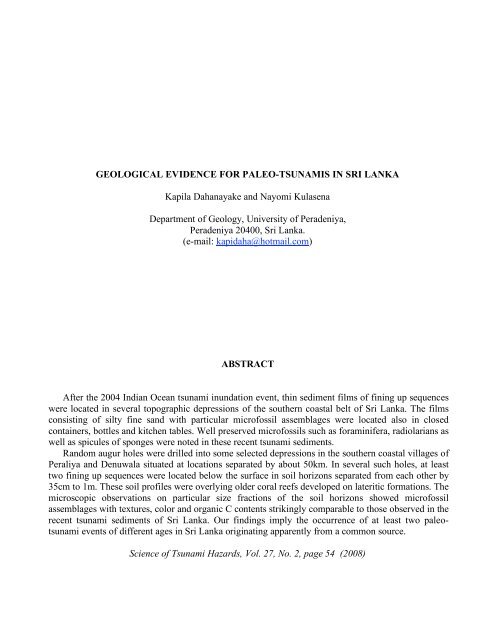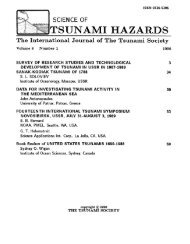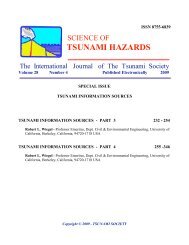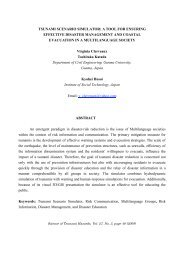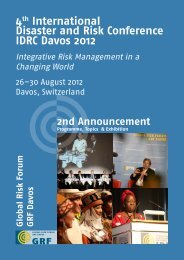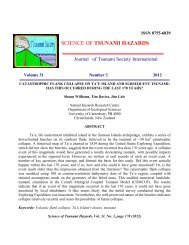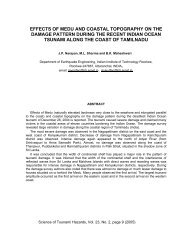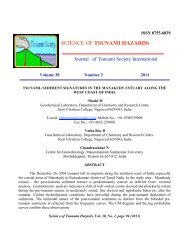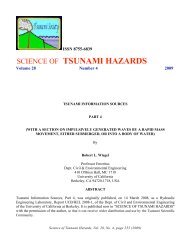GEOLOGICAL EVIDENCE FOR PALEO-TSUNAMIS IN SRI LANKA ...
GEOLOGICAL EVIDENCE FOR PALEO-TSUNAMIS IN SRI LANKA ...
GEOLOGICAL EVIDENCE FOR PALEO-TSUNAMIS IN SRI LANKA ...
Create successful ePaper yourself
Turn your PDF publications into a flip-book with our unique Google optimized e-Paper software.
where the recent tsunami waters had found their way via openings. Samples were also collected fromkitchen tables and open bottles located/stacked at heights of about 50cm above the ground surfacewhich were preferred sites for deposition of tsunami sediments (Dahanayake 2006). Random drillingof selected depressions was done in the coastal villages of Peraliya and Denuwala (Fig.1) whererecent tsunami sediments had preferentially accumulated. This led to the discovery of soil profileswith at least two stratigraphic horizons containing possible paleo-tsunami sediments. These were soidentified due to the comparable grain size distribution, microfossil content, Organic C and CalciumCarbonate contents, color and texture as in known recent tsunami sediments. In these oldersedimentary deposits the fining upward character was also observed.Fig. 1- Map of Sri Lanka showing the locations of the coastal villages of Peraliya and DenuwalaScience of Tsunami Hazards, Vol. 27, No. 2, page 56 (2008)
) In both types of sediments, assemblages of microfossils as well as sub rounded quartz grainswere found more or less exclusively on the fraction retained on the 0.125 mm sieve (Fig. 3).c) The above observations highlight the similarities of both 2004 tsunami and paleo-tsunamisediments collected from the Southern coastal region of Sri Lanka in grain size distribution aswell as microfossil contents.4. DISCUSSION AND CONCLUSIONSThe microfossil content, textural and compositional attributes of Recent tsunami sediment samplescollected from various locations were strikingly similar to those sediment horizons lying at depthsranging from 35cm to 1m in the soil profiles studied. These observations suggest (a) at least two pasttsunami events and (b) the arrival of tsunami waters across a common source area which had beenagitated due to breaking of tsunami waves in a relatively shallow ocean environment. The similarityof texture, color and composition with comparable microfossil assemblages of radiolarians,foraminiferans, and diatoms in both recent and older sediment layers suggest a paleo -tsunami originfor the older stratigraphic horizons. At least two such events are represented in the soil profilesstudied. There are references in ancient texts such as Jataka Stories and others to paleo-tsunamis in theIndian Ocean and the present observations confirm such historical observations. Currently efforts areunder way to determine radiocarbon dates for stratigraphically older horizons represented in the soilprofiles studied.AcknowledgementsThe authors wish to thank Prof. Atula Senaratne, Dr H.M.T.G.A.Pitawala, Dr Ms. SudharmaYatigammana - colleagues of one of us (K.D) at the Departments of Geology and Zoology of theFaculty of Science, University of Peradeniya for their assistance in analyzing the samples andidentification of microfossils. Ms Sepa Nanayakkara, Research Officer at the Industrial TrainingInstitute (ITI), Colombo kindly assisted with SEM studies. Ms Menaka Hindagolla, Senior AssistantLibrarian at the University Library of Peradeniya helped in bibliographic searches. Finally thekindness of the villagers of tsunami-stricken southern coastal region of Sri Lanka is remembered withgratitude. A generous research grant (RG/2005/DMM/05) for one of us (K.D) from National ScienceFoundation (NSF) of Sri Lanka is gratefully acknowledged.Science of Tsunami Hazards, Vol. 27, No. 2, page 60 (2008)
5. REFERENCESDahanayake, K. (2006) Science at the Solstice: A day in the life of a scientific planet, Abstract onTsunami sediments. Nature, v.441, pp.1040-1045.Geiger, W. (Translator), (1934) The Mahawamsa (The Great Chronicle of Ceylon-Sri Lanka) OxfordUniversity Press London, (in Sinhala).Hickman, C. P., Roberts, L. S., Larson, A. (2001) Integrated Principles of Zoology. McGraw-HillNew YorkKruger, F., Ohrnberger, M. (2005) Tracking the rupture of the M w = 9.3 Sumatra earthquake over1150km at teleseismic distance, Nature, v.435, pp.937-939.Liu, P.L.F., Lynett, P., Fernando, H., Jaffe, B.E., Fritz, H., Higman, B., Morton, R., Goff, J.,Synolakis, C. (2005) Observations by the International Tsunami survey Team in Sri Lanka.Science, v.308, p.1595.Nagendra, R., Kamalak Kannan, B.V., Sajith, C., Sen, G., Reddy, A.N., Srinivasalu, S. (2005) Arecord of foraminiferal assemblage in tsunami sediments along Nagappattinam coast, Tamil Nadu.Curr. Sci., v.89, pp.1947-1952.Prendergast, A. (2006) Echoes of ancient tsunamis. AusGeo News #83.Satyanarayana, K., Nallapa Reddy, A., Jaiprakash, B.C., Chidambaram, L., 2007. A note onforaminifera, grain size and clay mineralogy of tsunami sediments from Karaikal-Nagore-Nagapattinam beaches, Southeast Coast of India. Journal Geological Society of India, v.69, pp.70-74Stoddart, J. (2005) Tidal waves in Ceylon resulting from the Eruptions in the Straits of Sunda, August1883. Surveyor General’s Report, Ceylon (Sri Lanka). Island Newspaper, Sri Lanka Feb. 15.Suraweera, A. V. (2000) Rajavaliya- A Comprehensive account of the kings of Sri Lanka.Vishvalekha Publication, Sri Lanka.Tanioka, Y., Nishimura, Y., Hirakawa, K., Imamura, F., Abe, I., Abe, Y., Shindou, K., Matsutomi, H.,Takahashi, T., Imai, K., Harada, K., Namegawa, Y., Hasegawa, Y., Hayashi, Y., Nanayama, F.,Kamataki, T., Kawata, Y., Fukasawa, Y., Koshimura, S., hada, Y., Azumai, Y., Hirata, K.,Kamikawa, A., Yoshikawa, A., Shiga, T., Kobayashi, M., Masaka, S. (2004) Tsunami run-upheights of the 2003 Tokachi-oki earthquake. Earth Planet Space, v.56, pp.359-365.Uchida, J., Abe, K., Hasegawa, S., Fujiwara, O., Kamataki, T., Irizuki, T., Hirakawa, K. (2005)Characteristics of Faunal Succession of Foraminifera in Tsunami-deposits and Recognition ofSauce Area of Particles- A Case Study of the Holocene Tsunami Deposits at Tateyama, SouthernPart of the Boso Peninsula, Central Japan. Abstract American Geophysical union-#T11A-0361.Wijetunge, J.J. (2006) Tsunami on 26 December 2004: Spatial distribution of tsunami height and theextent o inundation in Sri Lanka. Science of tsunami hazards, v.24, pp.225-239.Science of Tsunami Hazards, Vol. 27, No. 2, page 61 (2008)


